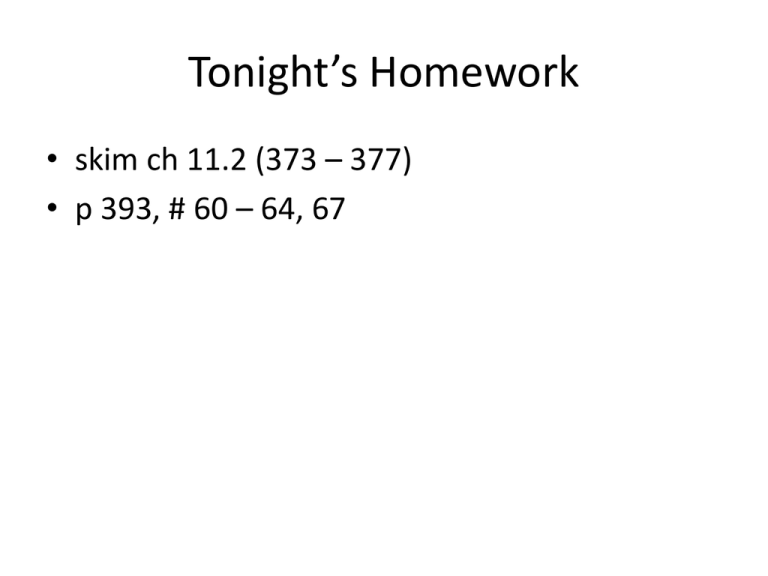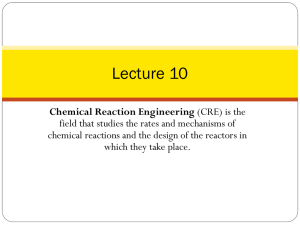Stoichiometric Calculations
advertisement

Tonight’s Homework • skim ch 11.2 (373 – 377) • p 393, # 60 – 64, 67 Homework Review 45. When tin(IV) oxide is heated with carbon in a process called smelting, the element tin can be extracted. SnO2(s) + 2C(s) Sn(l) + 2CO(g) Interpret the chemical equation in terms of particles, moles, and mass. Particles: 1 f.u. SnO2 + 2 atoms C 1 atom Sn + 2 molecules CO Moles: 1 mole SnO2 + 2 mole C 1 mole Sn + 2 mole CO Mass: 150.71 g SnO2 + 24.02 g C 118.71 g Sn + 56.02 g CO Homework Review 49. Solid silicon dioxide, often called silica, reacts with hydrofluoric acid (HF) solution to produce the gas silicon tetrafluoride and water. a. Write the balanced chemical equation for the reaction. SiO2 (s) + 4 HF (aq) SiF4 (g) + 2 H2O (g) b. List three mole ratios, and explain how you would use them in stoichiometric calculations. You should have listed 12 mole ratios. They are useful to convert from moles of one substance to moles of another. Homework Review 50. Chrome The most important commercial ore of chromium is chromite (FeCr2O4). One of the steps in the process used to extract chromium is the reaction of chromite with coke (carbon) to produce ferrochrome (FeCr2). 2C(s) + FeCr2O4(s) FeCr2 (s) + 2CO2 (g) What mole ratio would you use to convert from moles of chromite to moles of ferrochrome? 1 mole FeCr2 / 1 mole FeCr2O4 Homework Review 53. Antacids Magnesium hydroxide is an ingredient in some antacids. Antacids react with excess hydrochloric acid in the stomach to relieve indigestion. a. Balance the reaction of Mg(OH)2 with HCl. Mg(OH)2 + 2HCl MgCl2 + 2H2O b. Write the mole ratio that would be used to determine the number of moles of MgCl2 produced when HCl reacts with Mg(OH)2. 1 mol MgCl2 / 1 mol Mg(OH)2 OR 1 mol MgCl2 / 2 mol HCl Stoichiometric Calculations section 11.2 Mass Production (an analogy ) • 2-L bottles of soda • 100,000 bottles per order • Best case scenario, how many liters of soda should be “batched” at a time? • 200,000 L Thinking like a chemist… • “Balanced Chemical Equation” 1bottle + 2liters - of - soda =1filled - bottle - of - soda • Mole Ratio 2liters - of - soda 1bottle • Conversion 2liters - of - soda 100, 000bottles ´ = 200, 000liters - of - soda 1bottle The basics of stoichiometric conversions… • Best Case Scenario = Balanced Chemical Eqn. • The mole ratio is the missing link between the best case scenario (balanced chemical equation in moles) and reality (in grams). – DETERMINE mole ration FROM THE BALANCED EQUATION • 3 types of conversions – mole to mole – mole to mass – mass to mass For all of them, GO TO MOLES FIRST! • Use molar mass (MM) to convert between moles and mass. 3 groups – 3 reactions • https://www.youtube.com/watch?v=oqMN3y 8k9So • https://www.youtube.com/watch?v=Mx5JJWI 2aaw • https://www.youtube.com/watch?v=x2BXuI52 fOI 3 groups – 3 problems • Determine what type of conversion – mole to mole – mole to mass – mass to mass • Work through the problem to solve it. • Outline the steps to solve this type of problem. • Be prepared to teach it to your classmates. Summary – Determine given and unknown, then… moles given to moles unknown mole give to mass unknown mass given to mass unknown 1. Balance chemical equation. 1. Balance chemical equation. 1. Balance chemical equation. 2. Determine and use the mole ratio to relate moles unknown to moles given. 2. Determine and use the mole ratio to relate moles unknown to moles given. 2. Convert mass given to moles given using molar mass. 3. Convert moles unknown to mass using molar mass. 3. Determine and use the mole ratio to relate moles unknown to moles given. 4. Convert moles unknown to mass unknown using molar mass. = moles given x (moles unknown/moles known) = moles given x (moles unknown/moles known) x (MM unknown/1mole) = mass given x (1mole/MM) x (moles unknown/moles known) x (MM unknown/1 mole) Groups 1 & 2 • Potassium metal reacts vigorously with water to produce potassium hydroxide and hydrogen gas. If 0.0400 moles of potassium is used, how many moles of hydrogen gas is created? Groups 3 & 4 • Determine the mass of sodium chloride (NaCl) commonly called table salt, produced when 1.25 moles of chlorine gas (Cl2) reacts vigorously with excess sodium. Groups 5 & 6 • Gasohol is a mixture of gasoline and ethanol. Determine the mass of CO2 produced from the combustion of 100.0 g ethanol (C2H5OH).








